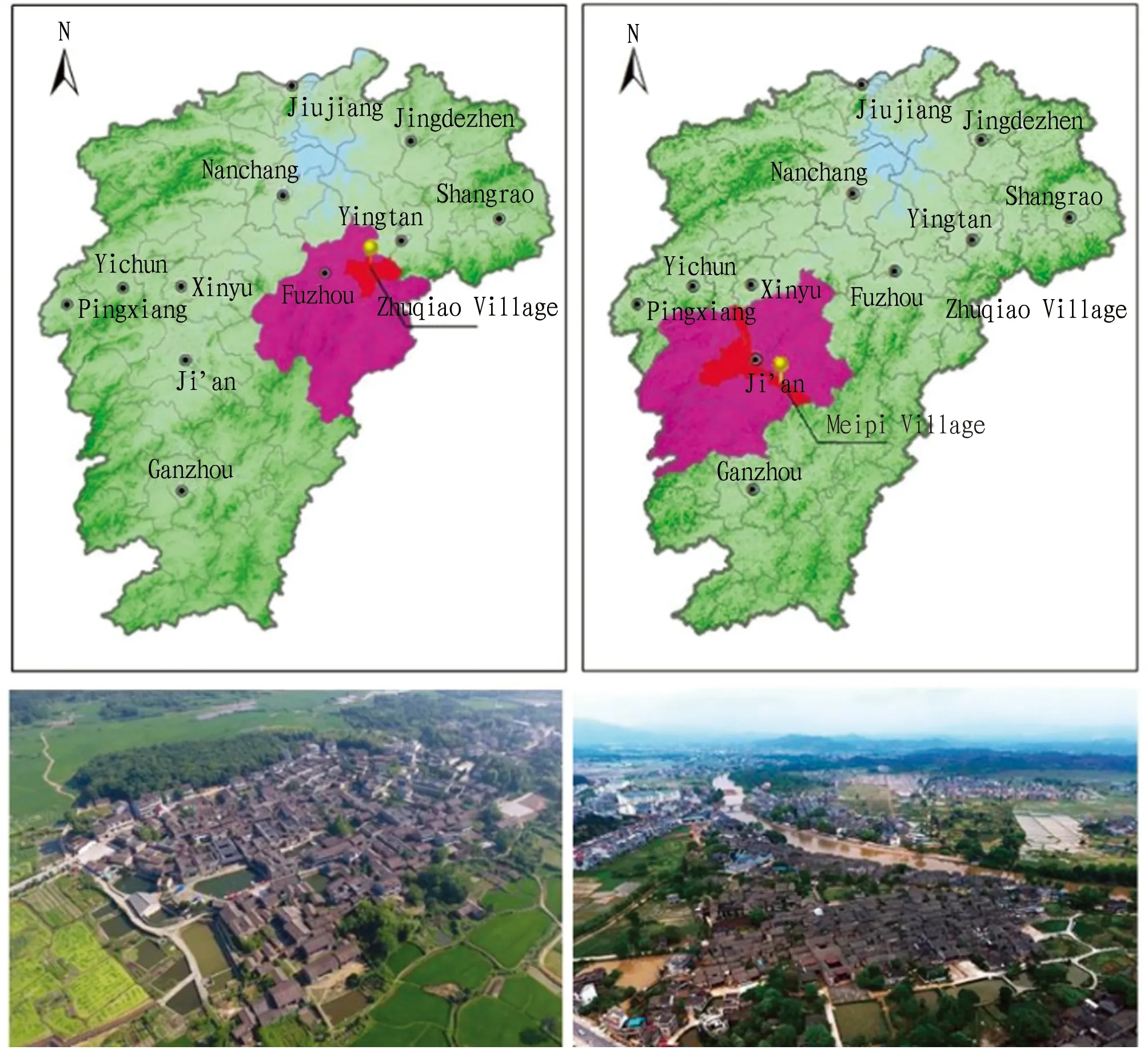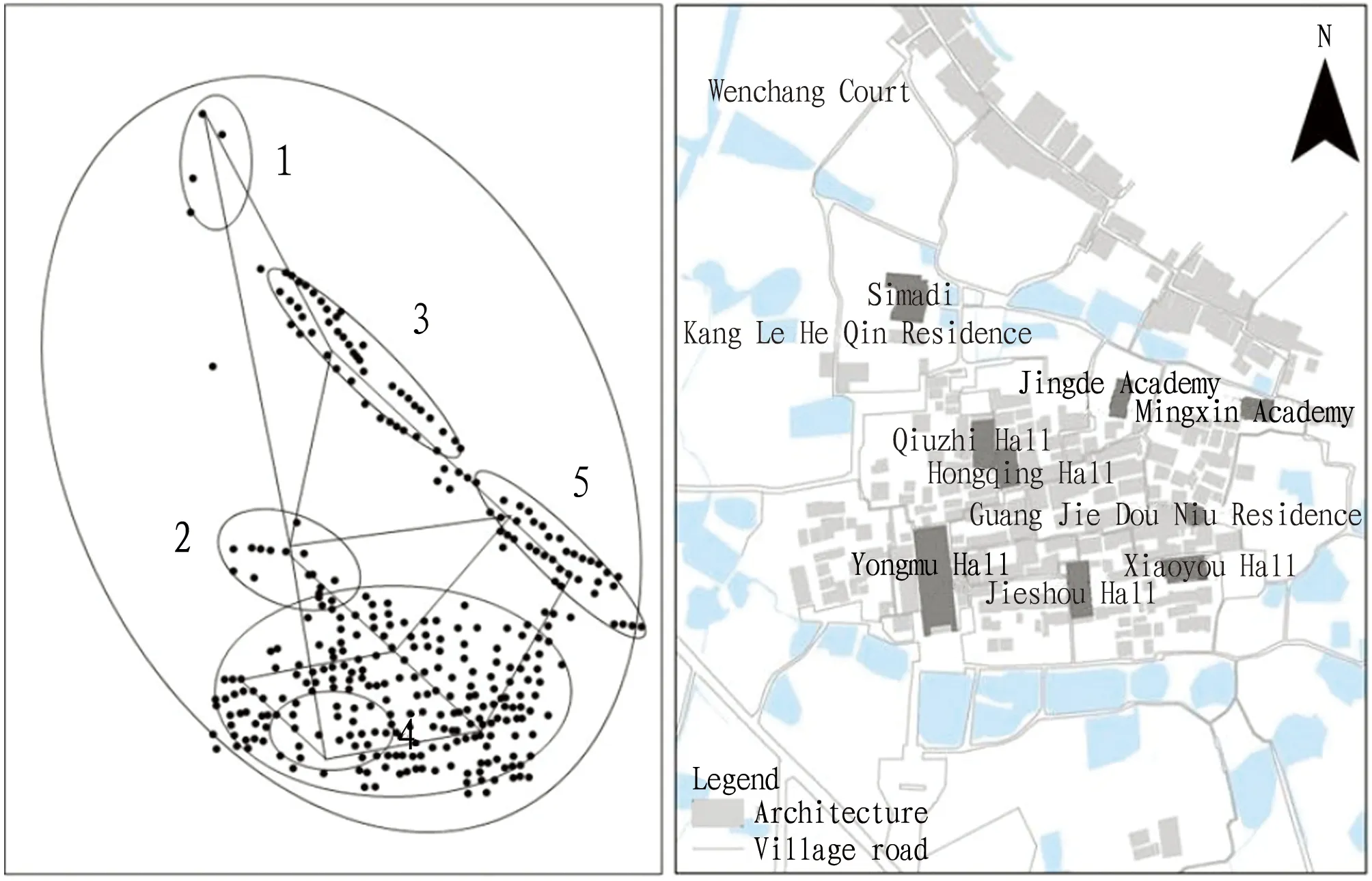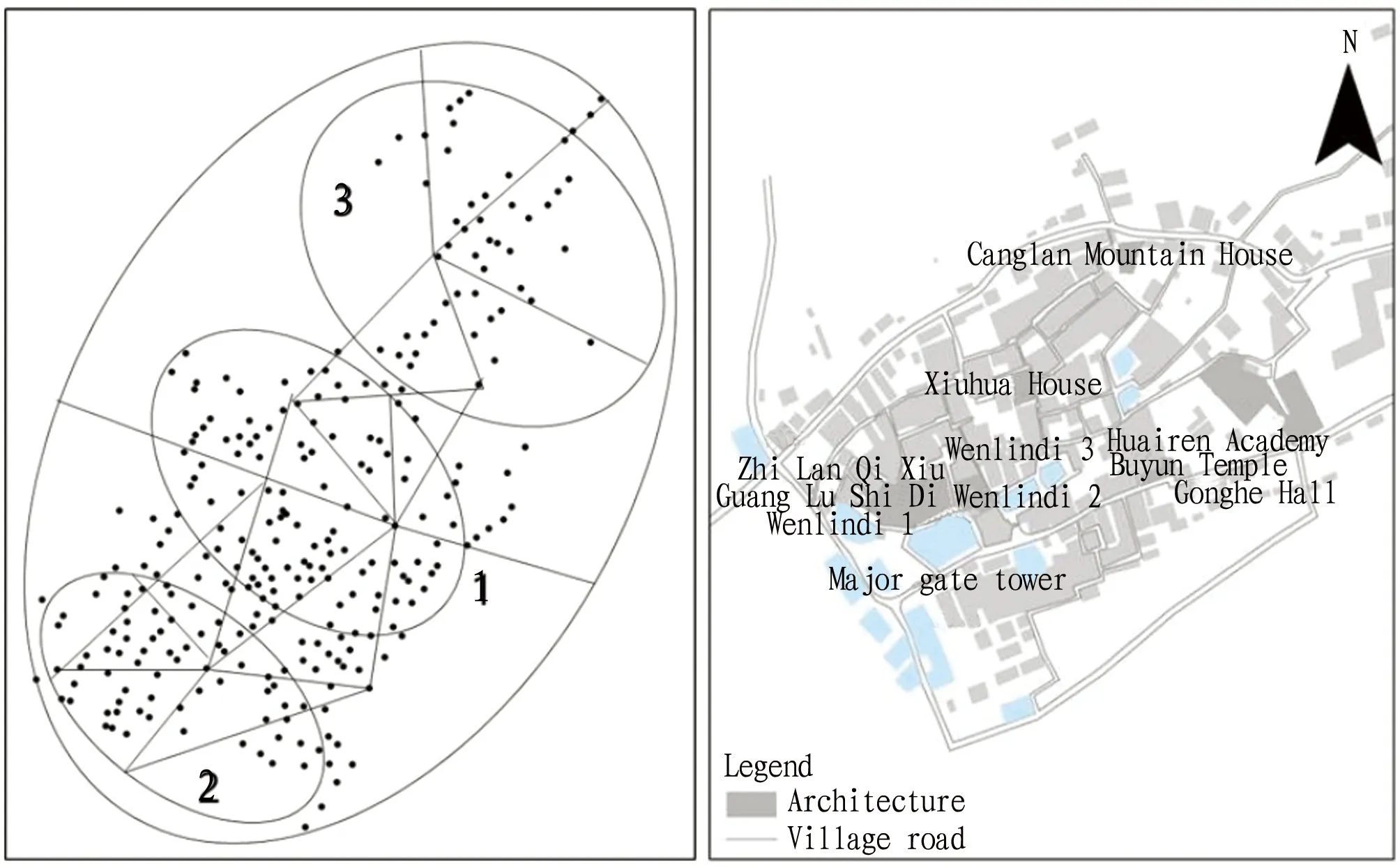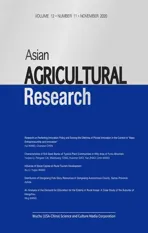Comparison of Spatial Forms between Villages under Different Cultures in Jiangxi Province: Taking Meipi Village and Zhuqiao Village as Examples
2020-12-30YuchengLIU
Yucheng LIU
Jiangxi Normal University, Nanchang 330022, China
Abstract Taking Meipi Village and Zhuqiao Village as the research objects, the external space, internal space and architecture form of the ancient villages were compared, and the law and essence of village pattern under different cultures were summarized in this article, so as to provide ideas for the preservation and continuation of Jiangxi’s history and culture and innovative rural development.
Key words Jiangxi, Ancient village, Form comparison
1 Introduction
China is a farming country with a history of 5 000 years of civilization. As the carrier of agricultural life, ancient villages have witnessed China’s historical development. In recent years, with the slogan of rural revitalization, the development and future of ancient villages has become an important starting point for China’s development. Keeping homesickness and retaining culture and memory are important issues in today’s planning. Therefore, the research on traditional villages not only responds to the call of the country, but also holds a deep love for the country’s culture. This article compares two ancient villages under different cultures in Jiangxi (Luling Culture: Meipi Village; Linchuan Culture: Zhuqiao Village), from aspects of externals space, internal space and public building, in order to provide a theoretical basis for the protection and development of traditional villages.
2 Comparison of external space between ancient villages
2.1LandscapeQingyuan District of Ji’an City, where Meipi Village is located, is one of the birthplaces of Luling Culture (Fig.1). The Ganjiang River in Jiangxi has many tributaries. The ancient village of Meipi is located on the bank of Fushui River, a tributary of the Ganjiang River. The whole village is built by the winding river in the north[1]. The natural environmental conditions around Meipi Village are superior. It is surrounded by Xiangfeng, Xiangling and Yao Mountain in the east, west and south, and adjacent to Fushui River in the north. The specific natural environment constitutes the foundation of the village.

Fig.1 Location of Zhuqiao Village and Meipi Village
2.2Road
2.2.1Meipi Village. The external roads of Meipi Village are divided into two types: expressway, provincial road and field road.
There is a provincial expressway S319 on the west side of Meipi Village. It leads north to Ji’an City, providing a convenient transportation route for visitors to Meipi Ancient Village. The provincial expressway also serves as the boundary of the village, delimiting the development boundary of Meipi Village. The village is bordered by the provincial expressway S319 and Fushui River, developing towards the north and south. There is a expressway around Ji’an City to the west of Meipi Village. The Ji’an City Ring Expressway is designed to relieve the internal traffic pressure. You can reach the provincial expressway S319 via the expressway and enter the scenic area of Meipi Village. It can be said that as a famous historical and cultural village, Meipi Village has excellent transportation advantages.
There are large tracts of farmland around Meipi Village, along the field roads. It is the main cultivated land of the village. Rural roads vary in width. The wide ones are suitable for tractors and other agricultural vehicles, and the narrow ones can be used by relatively small carts or motorcycles. The narrower ones can only allow people to walk on them. They are mostly treaded by villagers throughout the year, providing convenience for agricultural life. These roads are generally winding. Some are arranged in sequence along the ridges, which is conducive to agricultural activities.
2.2.2Zhuqiao Village. The external roads of Zhuqiao Village are also divided into two types: expressway, provincial road, country road, and field road.
The Jinan-Guangzhou Expressway passes through the east of Zhuqiao Village. To enter Zhuqiao Village, you need to take the national highway G206 on the east side, which heads to Fuzhou City westwards and to Yingtan City eastwards, then enter the country road from the national road and finally reach Zhuqiao Village. Compared with Meipi Village, the traffic in Zhuqiao Village is slightly inconvenient.
The farmland in Zhuqiao Village is mainly concentrated in the west of the village. Because the village is located in the foothills and the terrain is relatively steep, it is not suitable for planting crops. The terrain on the west side is slightly flat. Therefore, a large amount of farmland is concentrated on the west side of Zhuqiao Village. There is a lot of farmland, and field paths extend in all directions. The field roads are conducive to improving the efficiency of agricultural activities.
2.3PreliminarysummaryIn terms of macro site selection, Meipi Village and Zhuqiao Village have obvious similarities. They both front water with mountains on the back. The surrounding terrain is flat. It can be seen that the influence of traditional Chinese Fengshui theory is obvious. As the two villages were moved here to avoid the war, the thought of seclusion, the mentality of fear of big cities and the self-sufficiency mentality of farming are all manifested obviously. Although there are cultural differences, from the macroscopic external space, there are obvious similarities between the two villages.
3 Comparison of internal space between the ancient villages
3.1Overallstructure
3.1.1Meipi Village. The overall structure of Meipi Village is "two belts, five clusters, and multiple points" (Fig.2). The two belts are a cluster-shaped residential area with Yongmu Hall as the core and a strip-shaped commercial and residential area along the Fushui River with commercial functions as the core. The five clusters are the cluster centered on Yicang, Jiexiao Temple and Zhenhan Academy, the cluster with Simadi as the center, two clusters surrounded by buildings along the Meipi Ancient Street and Pitou Village, and the cluster centered on Yongmu Hall. Yongmu Hall is the administrative center of the village, spreading out at once, showing an obvious trend of gathering. Multiple points are scattered in the public space of the village. It can be seen that the two belts are not closely related in space. Commercial streets have a tendency to develop along the north, while residential areas develop eastward with Yongmu Hall as the core. The reason for the phenomenon is that Meipi Village was built in the early Southern Song Dynasty. This period was dominated by agricultural life, so the choice of location was more to consider the distance between the residence and the farmland to facilitate agricultural activities. The commercial culture came into being after the Ming Dynasty, when the commodity economy was further developed, and commercial profits far exceeded agricultural profits. With the advantage of water transportation, Jiangxi has made rapid development of commercial economy. The Fushui River is a tributary of the Ganjiang River. Of course, commercial districts have been established by virtue of location advantages. It is not difficult to see in the plan that the commercial blocks have a tendency to develop along the north and are developed close to the river. The multiple points are irregularly arranged in Meipi Village. They seem to be irregular, but in fact, most of the public buildings are located near the 28 ponds. It is guessed that choosing a public building next to the pond has a metaphor for praying for blessings. It can be seen that Fengshui theory has had a considerable impact on Meipi Village.

Fig.2 The plan and overall structure of Meipi Village
3.1.2Zhuqiao Village. The overall structure of Zhuqiao Village is "three belts, three clusters, and multiple points" (Fig.3). The village’s central business district is constructed with Zhi Street as the skeleton. The business district is closely connected with the north-south space and has a strong centripetality.

Fig.3 The plan and overall structure of Zhuqiao Village
The four gates are the central cluster. The ponds in the center constitute the center of the cluster as the core space. The cluster-style living space built along the outer streets is located in the north of Zhuqiao Village. Zhuqiao Village uses the south as its entrance. From south to north, you enter the political space, commercial area, and living area of Zhuqiao Village in success. First of all, the political space is placed at the entrance of the village to meet the political needs of the local village name, and to show the most beautiful aspect of Zhuqiao Village to the outside population. The commercial area is placed in the middle, with convenience as the consideration. Zhuqiao Village has valued commerce since ancient times. Engaging in commercial activities is the daily activity of the villagers. Therefore, the commercial space generated in the central area achieves maximum accessibility. The living space is freely arranged at the northernmost end. It satisfies the need for quietness and has a wide space so that the residences are not too crowded.
3.2Texture
3.2.1Meipi Village. (i) The streets of Meipi Village are divided into two categories. One category is "T"-shaped streets with residential area as the unit. "T"-shaped streets are arranged in a winding pattern. As can be seen, part of the streets is naturally formed by the creation of buildings. The scale is the size of the branch roads, and the width is between 3-4 m. They can accommodate 3-4 people passing through. The scale is pleasant. It can be said that the streets are born from the emergence of residential buildings. The narrow street reflects the formation of a more intimate street space because of the closeness of blood. The second category is linear streets in the northern business district with an "S" shape. They guide people from Pitou Street to Meipi Ancient Village, with bluestone slabs in the middle, which is convenient for the transportation of goods. There are drainage ditches on both sides to prevent precipitation from eroding the streets. The streets are mostly about 4 m wide. Some stores have a certain retreat. In the periphery of the village, the roads widen, mostly about 8-10 m. On the one hand, it is to facilitate the transportation function of the village, such as farm work. On the other hand, it is also convenient for outsiders to visit.
(ii) Open space is divided into two types. One is the open space in front of public buildings. Part of the open space is formed by square and pond, like Yongmu Hall, Jieshou Hall and Simadi. The purpose is to emphasize the importance of public space and highlight its dominant position. The other type is small squares formed by the retreat of the buildings. There is another type of open space where front doors of villager’s houses retreating a small part from the street. On the one hand, it is to facilitate communication between neighbors. On the one hand, it also reduces the resistance of passing pedestrians.
(iii) Meipi Village belongs to typical Jiangyou people. Its buildings mostly have the style of Jiangxi. Brick, wood and stone are the main construction materials. Wooden frame is the supporting system. The architecture is mostly quadrangle courtyards and triangle courtyards. There is also interspersed layout of quadrangle courtyards and triangle courtyards. The buildings have blue bricks and gray tiles, uniform in color. Family shrines and ancestral shrines are moderately widened and configured with two or three yards.
3.2.2Zhuqiao Village. (i) The streets of Zhuqiao Ancient Village are mainly fan-shaped. The roads are divided into horizontal and vertical streets. Horizontal streets are mainly used to connect the traffic of various areas in the whole village. The vertical streets connect the entrances to each household. The road planning of Zhuqiao Village is clearly hierarchical. The primary roads are used as the external traffic roads, with a width of about 10 m. The secondary roads are used to connect different functional areas. Possibly due to commercial reasons, taking into account the function of transportation, the roads are widened, with a width of about 6 m. The branch roads are used to connect the secondary arterial roads, which is convenient for villagers to directly enter the houses. The width is about 4 m, and the scale is pleasant. It can be seen that the roads in Zhuqiao Village are more scientific and efficient.
(ii) The open space of Zhuqiao Village is divided into two types. The type of being centered by pond is more famous. Part of the open space is centered by ponds. Buildings are constructed around the ponds at a certain distance to form a square space. The shape is unique. It is said that on the one hand, the ponds can meet the daily water use and drainage needs of the villagers. They can also be used as a defensive function to defend against thieves. When the burglars escape at night, they may fall into the ponds. The other type is semi-open space surrounded by walls and gate tower. Compared to Meipi Village, it is more private and solemn.
3.3PreliminarysummaryIn terms of microscopic public building, the overall structure of Meipi Village is looser than that of Zhuqiao Village. This is due to historical reason. The commercial development of Meipi Village during the Ming and Qing dynasties and the rise of water transportation made the village develop towards the riverside, leading to multi-cluster development of the village. Since land transportation in Zhuqiao Village was more developed, the structure of Zhuqiao Village is more concentric and more compact. This shows to some extent that the collective nature of Zhuqiao Village should be strengthened. From the perspective of overall area, Meipi Village is bigger than Zhuqiao Village. In terms of street texture, the streets of Zhuqiao Village are more hierarchical, while there is no obvious hierarchy in Meipi Village. It may be that Zhuqiao Village clusters different functional areas together, resulting in a higher demand for different transportation, so a hierarchical structure is formed. The residential and commercial areas of Meipi Village are separated, which leads to a relatively single type of traffic and simper layout. In terms of open space, Zhuqiao Village forms a series of open spaces around water and memorial buildings. However, most of the open space in Meipi Village is constituted of ancestral halls and squares. It can be seen that the cultural atmosphere of Zhuqiao Village is more lively. The cultural atmosphere of Meipi Village tends to be more sacrificial and more serious. There are also certain similarities between the two villages, such as similar building forms and building materials. The public activities surrounding the ancestral halls have the same identity to the sacrifice. They value commerce. This is the characteristics contained in the commonalities.
4 Comparison of microscopic public buildings between ancient villages
4.1Typesofpublicbuildings
4.1.1Meipi Village. There are 20 public buildings in Meipi Village (Table 1), and public buildings are divided into four types: political, life, commercial, and educational, including Yongmu Hall, Qiuzhi Hall and Jingde Academy. In terms of types, most of them are political and educational public buildings. In addition, as the red revolutionary base, Meipi Village has preserved some old residences of celebrities. These buildings are unified into life-type public buildings. There are 9 political buildings. Among them, Yongmu Hall is the leader, and located at the entrance of the gate building of Meipi Village. Together with the square Pantang on the south and the buildings on both sides, it forms the entrance space of Meipi Village. Some branch temples and family temples, such as Qiuzhi Hall, Xiaoyou Hall and Hongqing Hall are also included. Among these ancestral halls, 6 are Liang’s ancestral halls, which are used to commemorate ancestors. Although the ancestors moved from Shaanxi to Jiangxi 100 years ago with a long history, the name of the village did not forget to commemorate the ancestors. It can be seen that the concept of filial piety in Confucianism is deeply imprinted in the culture of Meipi Village. These political buildings also include the Hanlindi Gate Tower, which shows that Meipi Village attaches great importance to education. Another type of public architecture is educational buildings, which reached its peak in the Qing Dynasty, including Jingde Academy, Mingxin Academy and Zhenhan Academy. There is also the Wenchang Pavilion like today’s library, and it provides hard resources for education. A good educational environment has also created many "super scholars", such as Taichang scholar Liang Zhaobo and Jiangzhou professor Liang Junyong. Tthere is a gatehouse in Meipi Village called Hanlindi Gate Tower. This is to commemorate Liang Jiazhang, an ancient scientific expedition figure. Liang Jiazhang struggled all his life in the imperial examinations and did not get his fame until he was 69 years old. The villagers admired his fame and built this gate tower. In the second entrance of the Yongmu Hall, there is also a sign of Hanlindi. It can be seen that the villagers attach great importance to imperial examination education.

Table 1 Open space in Zhuqiao Village
4.1.2Zhuqiao Village. There are 18 public buildings in Zhuqiao Village (Table 2), most of which are political and living. There are 8 political public buildings. Among them, most are gate towers and ancestral halls. There are four gate towers: major gate tower, upper gate tower, middle gate tower and lower gate tower. Gate towers are the symbol of Zhuqiao Village. It can be seen from the name of the village that the village has attached importance to the domain space. Secondly, gate tower is a symbol of the wealthy people in ancient times. It can be seen that the mercantile Zhuqiao Village was relatively wealthy in the local area. The second is the ancestral halls, such as Wenlong Ancestral Hall, Zhenshan Gong’s Temple and Blessing Temple. It can be seen that, just like Meipi Village, sacrifice to the martyrs is also one of the important activities in Zhuqiao Village. Yangzheng Mountain House was used as a place for carving and printing ancient books. Woodblock printing is China’s intangible cultural heritage. Zhuqiao Village is the birthplace and main printing site of Jinxi books. Dozens of engravings such asThree-characterCanon,HundredsofSurnamesandConcourseofCommentariesontheFourBooksare preserved in the village. Sculpture culture has also become an important pillar to promote the local economy. There are 6 life-type public buildings, of which the main functions are entertainment, leisure, daily life,etc. It can be seen that in daily life, the villagers pay more attention to leisure activities.

Table 2 Open space in Meipi Village
4.2Characteristicpublicbuildings
4.2.1Meipi Village. Characteristic public buildings in Meipi Village include Yongmu Hall, 28 ponds, and the Former residence of Zeng Shan (Fig.4). Yongmu Hall is the general ancestral hall of Meipi Village. It was built in Song Dynasty. After being destroyed and undergoing many renovations, it was fateful. Yongmu Hall is divided into upper, middle, and lower parts. It is a two-story three-entry courtyard building with two large patios. The surface width is 19.7 m and the depth is 62 m, covering an area of 1 220 m2. There are three rooms in front of Yongmu Hall. A tall archway was built on the porch, in the shape of an official hat. The words “Han Lin Di” is hang on the archway to commemorate Liang Jiazhang who had passed the imperial examination. Yongmu Hall has 37 maroon pillars, on which someone can engrave couplets. There are also 28 ponds, which symbolize the 28 stars in the sky guarding Meipi Village. There are many ancestral halls in places with larger ponds, such as Yongmu Hall with 28 ponds in the front, symbolizing the endless life and prosperity of future generations. The Former residence of Zeng Shan is at No.3, Meipi Village, where Mao Zedong also ever lived. As the residence of the former Soviet government, Meipi Village hosted the famous "February 7th Conference". Baptized by the red culture, Meipi Village not only has a rich history and culture, but also has a heavy red culture.

Note: a. 28 Ponds; b. Yongmu Hall; c. Former residence of Zeng Shan.
4.2.2Zhuqiao Village. Characteristic public buildings in Zhuqiao Village include three square wells in a triangular shape, moon-shaped pond accompanied by seven ponds and four gate towers (Fig.5). The three square wells are located at the entrance of Zhuqiao Village. They warn future generations that one must pay attention to moral character, which is the foundation of a foothold. The moon-shaped pond accompanied by seven ponds provides domestic water for the villagers and constitute the village’s drainage system. The major gate tower has a house-style and brick-wood structure, dominating the entrance space of Zhuqiao Village. The upper gat tower has an archway style. The facade is a red stone frame with four columns and three doors, with an inverted seat behind it. It was established to commemorate Yu Changyan, the ancestor of the Song Dynasty. The middle and lower gates are both doorway-styled and relatively low. The middle gate is shaped like an official hat. The lower gate is designed as a village refuge road.

Note: a. Middle gat tower; b. Three square wells in a triangular shape; c. Moon-shaped pond.
4.3PreliminarysummaryThe public buildings of the two villages are mainly sacrificial. It can be seen that the influence of the Confucian culture of "remembering the ancestors" is still great. The difference is that in addition to the sacrifices, the proportion of educational public buildings in Meipi Village is higher than that in Zhuqiao Village, however, the proportion of life-oriented public construction in Zhuqiao Village is higher than that in Meipi Village. It can be seen that Meipi Village pays more attention to education while developing business, and Zhuqiao Village pays more attention to improving the quality of life. This also led to a significantly higher number of people admitted to official careers in Meipi Village than in Zhuqiao Village. In the comparison of characteristic buildings, it is found that Meipi Village pays more attention to the design of sacrificial space, while Zhuqiao Village pays attention to Fengshui and has more public service space. They all have the same preference for Fengshui. In terms of culture, the farming culture and mercantile culture are same. The difference is that Meipi Village has a red culture, while Zhuqiao Village has a printing culture. The two villages have different characteristics of cultural heritage.
5 Conclusions
In this article, it is found that ancient villages under different cultures have similarities such as location, content of public life and development of commercial culture, and also have differences including structure, road texture and content of daily life. The villages have their own history. We should respect history, conform to culture, and plan to continue their context, rather than to ignore the facts. Only in this way, can the history be better protected, and homesickness be kept.
杂志排行
Asian Agricultural Research的其它文章
- Resident Relocation of Wulingyuan World Natural Heritage Site Based on Community Participation Theory
- Exploration on Ecological Compensation Mechanism of Family Farm
- Distribution of Dongxiang Folk Story Resources in Dongxiang Autonomous County, Gansu Province
- Characteristics of Soil Seed Banks of Typical Plant Communities in Hilly Area of Funiu Mountain
- Influence of Social Capital on Rural Tourism Development
- An Analysis of the Demand for Education for the Elderly in Rural Areas: A Case Study of the Suburbs of Hangzhou
